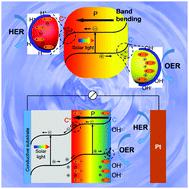当前位置:
X-MOL 学术
›
Nanoscale Horiz.
›
论文详情
Our official English website, www.x-mol.net, welcomes your feedback! (Note: you will need to create a separate account there.)
Implementation of ferroelectric materials in photocatalytic and photoelectrochemical water splitting.
Nanoscale Horizons ( IF 9.7 ) Pub Date : 2020-06-18 , DOI: 10.1039/d0nh00219d Yi Li 1 , Jun Li , Weiguang Yang , Xudong Wang
Nanoscale Horizons ( IF 9.7 ) Pub Date : 2020-06-18 , DOI: 10.1039/d0nh00219d Yi Li 1 , Jun Li , Weiguang Yang , Xudong Wang
Affiliation

|
As a promising technology for sustainable hydrogen generation, photocatalytic (PC) and photoelectrochemical (PEC) water splitting have gathered immense attention over a half-century. While many review articles have covered extensive research achievements and technology innovations in water splitting, this article focuses on illustrating how the ferroelectric polarization influences charge separation and transportation in photocatalyst heterostructures during PC and PEC water splitting. This article first discusses the fundamentals of PC and PEC water splitting and how these electrochemical processes interact with the ferroelectric polarization-induced interfacial band bending, known as piezotronics. A few representative ferroelectric material-based heterogeneous photocatalyst systems are then discussed in detail to illustrate the effects of polarization, space charge region, and free charge concentration, which are critical factors determining the ferroelectric influences. Finally, a forward looking statement is provided to point out the research challenges and opportunities in this promising interdisciplinary research field between ferroelectrics and electrochemistry for clean energy applications.
中文翻译:

铁电材料在光催化和光电化学水分解中的实现。
作为可持续氢生成的一项有前途的技术,光催化(PC)和光电化学(PEC)的水分解技术在半个世纪以来受到了广泛的关注。尽管许多评论文章涵盖了水分解方面的广泛研究成果和技术创新,但本文着重说明在PC和PEC水分解过程中铁电极化如何影响光催化剂异质结构中的电荷分离和迁移。本文首先讨论PC和PEC水分解的基本原理,以及这些电化学过程如何与铁电极化引起的界面带弯曲(称为压电)相互作用。然后详细讨论了一些基于铁电材料的代表性多相光催化剂体系,以说明极化,空间电荷区域和自由电荷浓度的影响,这是决定铁电影响的关键因素。最后,提供了前瞻性声明,指出了在清洁能源应用中铁电与电化学之间这一有前途的跨学科研究领域中的研究挑战和机遇。
更新日期:2020-07-27
中文翻译:

铁电材料在光催化和光电化学水分解中的实现。
作为可持续氢生成的一项有前途的技术,光催化(PC)和光电化学(PEC)的水分解技术在半个世纪以来受到了广泛的关注。尽管许多评论文章涵盖了水分解方面的广泛研究成果和技术创新,但本文着重说明在PC和PEC水分解过程中铁电极化如何影响光催化剂异质结构中的电荷分离和迁移。本文首先讨论PC和PEC水分解的基本原理,以及这些电化学过程如何与铁电极化引起的界面带弯曲(称为压电)相互作用。然后详细讨论了一些基于铁电材料的代表性多相光催化剂体系,以说明极化,空间电荷区域和自由电荷浓度的影响,这是决定铁电影响的关键因素。最后,提供了前瞻性声明,指出了在清洁能源应用中铁电与电化学之间这一有前途的跨学科研究领域中的研究挑战和机遇。


























 京公网安备 11010802027423号
京公网安备 11010802027423号